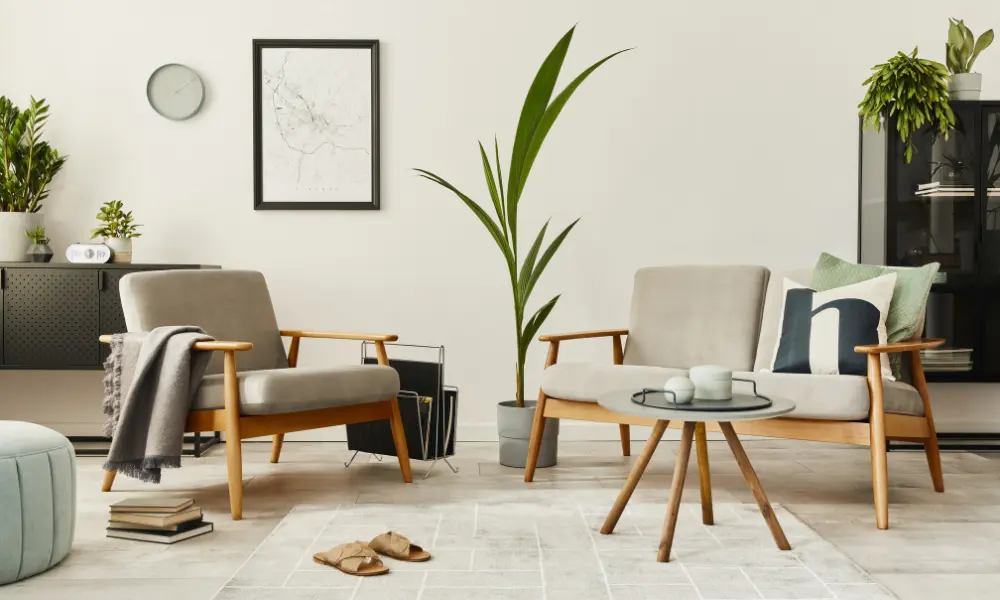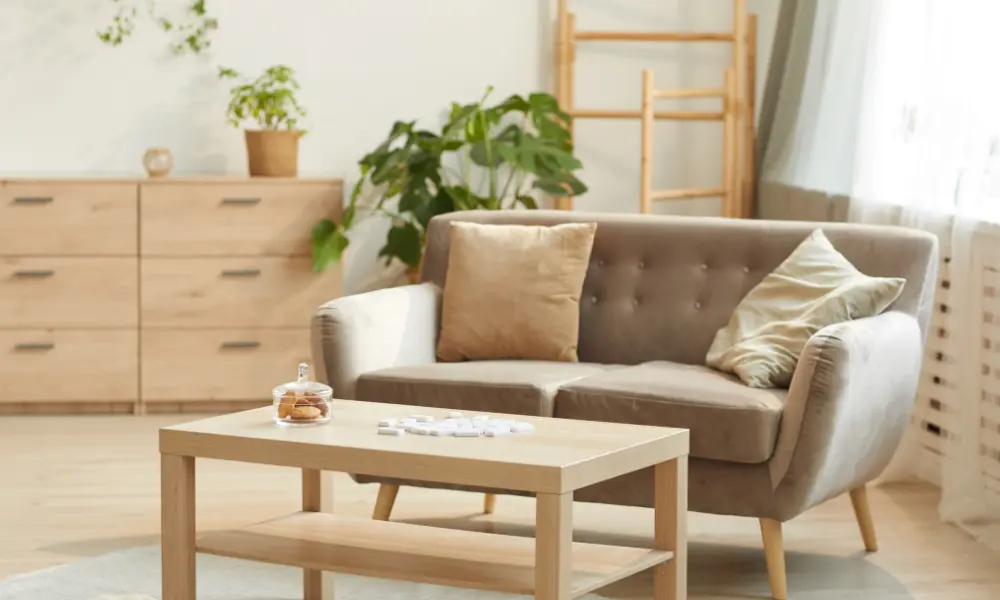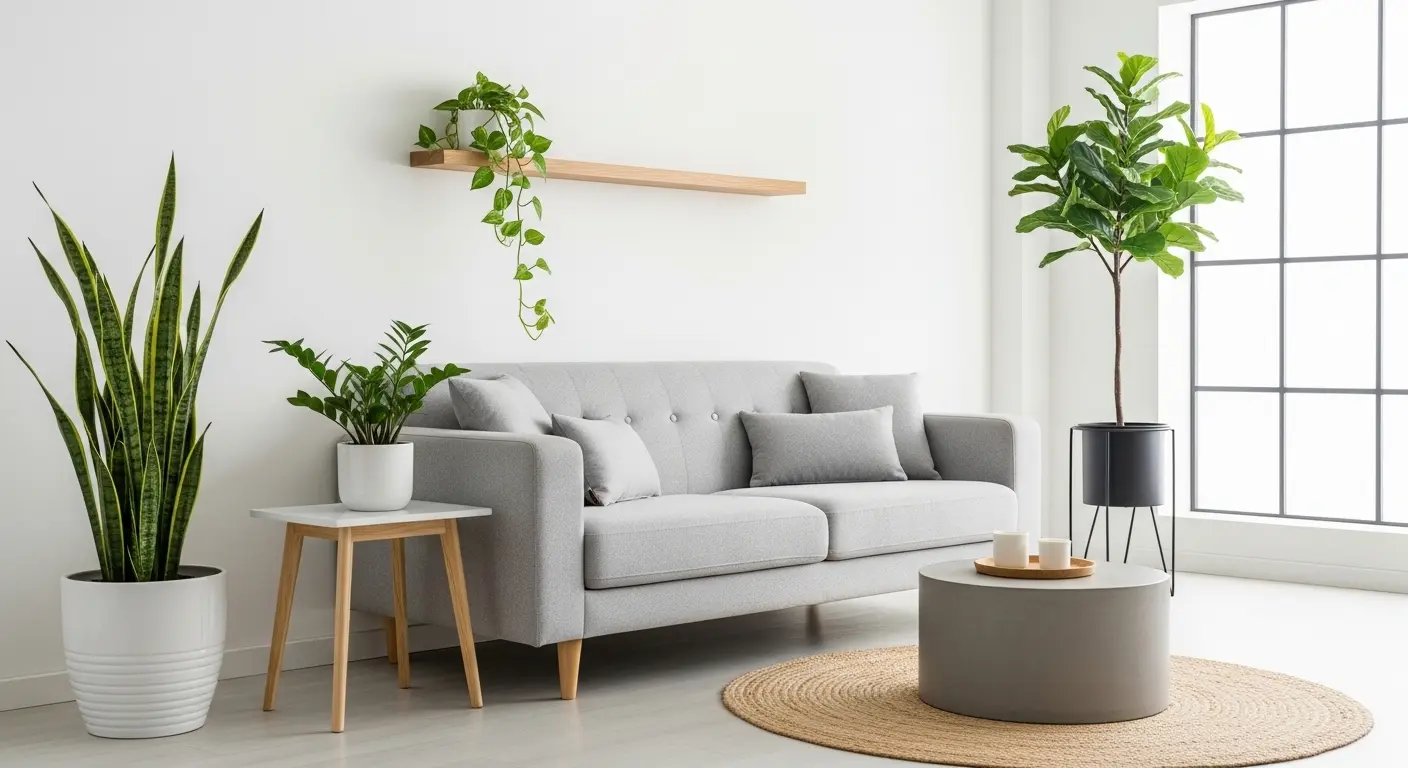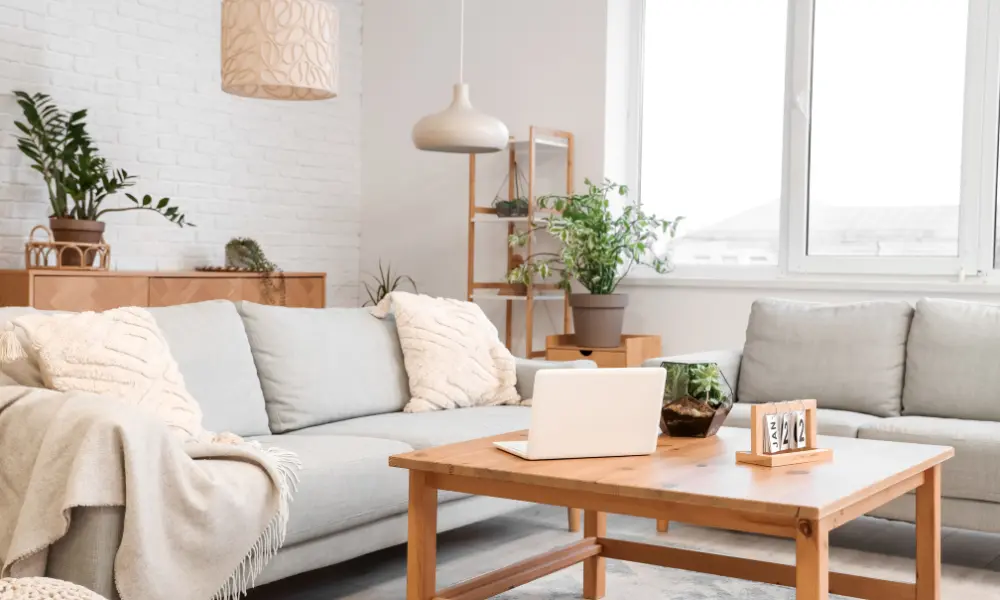
Decorating with plants brings life and coziness, but excessive pots and random choices can end up visually cluttering the environment.
The good news is that it’s possible to integrate greenery into your decor in a balanced and intentional way, respecting minimalist aesthetics and maintaining visual lightness.
In this article, you’ll discover how to decorate with plants without visually cluttering your space, learning to enhance each area with harmony, functionality, and just the right touch of nature.
The role of plants in minimalist decor
Minimalist decor seeks to value the essential, creating clean, organized, and visually calm environments. But this doesn’t mean living in cold or characterless spaces. This is precisely where plants enter as discreet protagonists, bringing life, texture, and balance without compromising simplicity.
Incorporating greenery strategically allows you to enrich the space naturally, without falling into visual excess. Plants aren’t mere decorative objects—they fulfill aesthetic, sensory, and even emotional functions, reinforcing the philosophy of “less, but better”.
Next, we’ll explore how plants integrate with this concept, respecting visual balance and enriching the minimalist living experience.
Connecting with nature indoors
We live in increasingly urban environments, disconnected from daily contact with nature. Bringing plants indoors is a simple and effective way to restore this connection, promoting a sense of calm, freshness, and well-being.
Biophilia—the concept that describes humans’ innate affinity with nature—reinforces the importance of this relationship. Studies show that the presence of plants in indoor environments helps reduce stress, increase concentration, and improve air quality.
In the minimalist context, plants act as an organic counterpoint to concrete, glass, and metal. Amid straight lines and neutral palettes, they soften the environment without visually cluttering it, as long as they’re introduced with intention.
Applied example: A single ZZ plant in a matte ceramic pot can transform the atmosphere of a room without compromising the clean aesthetic.
The importance of “empty space” in minimalism
In minimalism, empty space isn’t synonymous with absence but rather an intentional resource. “Emptiness” enhances present elements, creates visual breathing room, and promotes a sense of order and tranquility.
When decorating with plants, it’s essential to respect this philosophy. This means avoiding the accumulation of pots in every corner and prioritizing quality over quantity.
A single well-positioned plant can have much more impact than several randomly scattered ones. The secret is to create breathing spaces around the greenery, allowing it to stand out without competing with other elements.
For strategic arrangement ideas, check out our article How to Create a Minimalist Environment with Natural Elements.

How to avoid visual clutter when using plants
Integrating plants into your decor harmoniously requires more than simply choosing beautiful species. You need a strategic eye to avoid transforming your environment into an “improvised garden,” where visual excess compromises the lightness and organization so valued in minimalism.
In this section, you’ll learn the main precautions to avoid visual clutter when decorating with plants.
Conscious choice: few but good
In minimalism, each element has a purpose. With plants, it’s no different. Conscious choice begins with the question: does this plant really add to the space or is it just filling a void?
Choose species that have sculptural form, clean foliage, and striking visual presence, even in small proportions. Instead of many small pots scattered around, prioritize 2 or 3 well-selected plants that dialogue with the environment.
Practical example: A Snake Plant (Sansevieria) in a simple cylindrical pot can create a much more interesting visual impact than several small succulents grouped without criteria.
💡 Extra tip: Value species that also bring functional benefits, such as air purification or humidity control.
Proportion and scale: plants in the right size for the space
Another common mistake is disregarding the proportion between plant, pot, and environment. In compact spaces, large plants can “suffocate” the decor. On the other hand, very small plants can visually disappear and seem “lost.”
The secret is in scaling correctly:
- For corners and free areas, use medium-sized plants with vertical visual appeal.
- For low furniture, prefer small pots with light foliage.
- For shelves and bookcases, use hanging plants or compact ones with controlled growth.
Practical example: A Spider Plant hanging from a high shelf creates visual movement without invading useful space.
How colors and textures influence the lightness of the environment
In minimalism, the color palette is a protagonist. When including plants, it’s important to consider:
- Foliage in deep or light green tones that dialogue with the colors of the environment.
- Pots in neutral tones (white, beige, gray, burnished cement) or natural materials (clay, fiber, light wood).
Avoid mixing vibrant colors or contrasting textures in excess. The focus should be on harmony and visual continuity.
Practical example: In an off-white environment, a matte ceramic pot with a Pilea or Peperomia complements the aesthetic without creating visual clutter.
Additionally, some species contribute not only visually but also with functional benefits, such as improving air quality. If you’re looking for plants that combine beauty and practicality in small spaces, check out the selection in Small But Powerful: Plants that Purify the Air in Compact Spaces.
Strategies for integrating plants without weighing down the environment
Decorating with plants in a minimalist environment requires more than just choosing beautiful species. The key is how you distribute, align, and integrate each pot strategically, without compromising visual lightness.
This section presents the best strategies for including greenery in an elegant, functional way without excess.
Intelligent use of stands, niches, and hanging pots
When space is limited, the secret to not visually cluttering the environment is to take plants off the floor and utilize vertical surfaces. Elevated stands, built-in niches, and hanging pots allow you to integrate greenery without compromising circulation while maintaining a clean aesthetic.
Niches and floating shelves offer a perfect base for displaying compact plants, maintaining an organized and discreet composition. Hanging pots create visual movement, elongating the perception of height in the environment without occupying useful areas.
The most important thing is to maintain visual cohesion:
- Choose stands and niches in neutral materials, such as light wood, matte black metal, or white.
- Avoid mixing conflicting styles that might create visual noise.
Practical example: A hanging Pothos in a ceramic pot suspended by macramé in a corner of the living room adds life without interfering with the flow of the space.

Visual composition: alignment, symmetry, and breathing room
The way you organize plants in the environment is as important as the choice of species. Good alignment creates order and reinforces the feeling of tranquility.
- Alignment: Position plants in line with furniture or along existing visual axes (such as shelves and countertops).
- Symmetry: Use identical pairs of pots at opposite points to balance the visual.
- Breathing room: Leave empty spaces between elements. This avoids the feeling of accumulation and allows each plant to “breathe” visually.
Practical example: On a bookshelf, alternating books with small Peperomia pots, respecting symmetry and leaving empty niches, creates a sophisticated and light effect.
This composition not only organizes the visual but also values each element in a balanced way.
The power of punctual greenery: less quantity, more impact
In minimalism, a single well-positioned plant can have more impact than several arranged without planning.
The concept of “punctual greenery” consists of using few plants, but strategically:
- As a focal point in a neutral room.
- To soften straight lines of furniture or rigid architecture.
- As a contrast element in monochromatic environments.
Practical example: A ZZ plant in a white pot in the corner of the living room, combined with an off-white palette, creates an elegant and minimalist look without the need for other complements.
This approach allows the greenery to stand out, maintaining the lightness of the environment and respecting the principle of “less is more.”

Which plants best complement minimalist decor
Choosing the right plants is fundamental to maintaining visual harmony and lightness in minimalist environments. The secret is to opt for species with clean foliage, sculptural forms, and easy maintenance. Below, you’ll find the best options for integrating greenery into your home without compromising simplicity.
Species with clean foliage and sculptural shapes
Plants with simple and elegant lines are most suitable for minimalism. They create a point of organic contrast, breaking the rigidity of the environment without generating visual excess.
Main examples:
- ZZ Plant (Zamioculcas zamiifolia): dark green, glossy foliage with vertical and sculptural form. Requires little light and maintenance.
- Fiddle Leaf Fig (Ficus lyrata): wide leaves with striking texture, ideal as a focal point.
- Snake Plant (Sansevieria): rigid and vertical leaves, perfect for compact spaces.
These species complement straight-lined furniture, neutral palettes, and enhance the concept of “less is more.”
Versatile plants for small spaces
For those living in apartments or compact spaces, it’s essential to choose plants that are versatile and proportional to the environment.
Practical suggestions:
- Pilea peperomioides: also called “Chinese money plant,” with rounded leaves and compact size.
- Peperomia: various varieties with delicate textures and excellent performance in niches and shelves.
- Pothos (Epipremnum aureum): hanging, easy to control visual volume with light pruning.
These plants adapt well to shelves, side tables, and hanging supports, optimizing space and maintaining lightness.
Examples of plants that “decorate without cluttering”
To facilitate your choice, here are some examples of plants that balance aesthetics and functionality in the minimalist context:
| Plant | Visual | Best Location | Benefits |
|---|---|---|---|
| ZZ Plant | Sculptural and elegant | Corners, entrance | Low maintenance, purifies air |
| Pilea peperomioides | Compact and modern | Shelves, tables | Great for small spaces |
| Peperomia | Textured and discreet | Niches, countertops | Light visual and easy to care for |
| Snake Plant | Vertical and robust | Hallways, corners | Resistant and purifying |
| Hanging Pothos | Fluid and delicate | High shelves | Purifies air, controllable growth |
These plants not only decorate but also improve well-being, reinforcing the concept of functional minimalism.
Common mistakes when decorating with plants (and how to avoid them)
Integrating plants into minimalist decor may seem simple, but some subtle errors can compromise the lightness and harmony of the environment. Next, we’ll address the most common missteps—and, of course, how to avoid them.
Accumulation of pots without planning
One of the most frequent mistakes is adding pots without criteria, just to fill “empty spaces.” In minimalism, free space is as important as the elements present. The accumulation of excess plants transforms what should be a tranquil environment into a visually heavy space.
How to avoid:
- Plan the distribution of plants as part of the decorative project.
- Prioritize quality and intention: it’s better to have 2 or 3 well-positioned plants than several pots without purpose.
- Use the concept of punctual greenery to create impact without excess.
Excess of colors and disconnected styles
Another common mistake is mixing plants with very vibrant foliage or using pots of colors and textures that don’t dialogue with the environment. This lack of visual cohesion breaks minimalist simplicity.
How to avoid:
- Choose species with green tones that complement the environment’s palette.
- Use pots in neutral materials: matte ceramic, cement, light wood, or natural fibers.
- Avoid patterns, vibrant colors, or mixtures of styles that create visual noise.
Practical example: Keeping a Snake Plant in a burnished cement pot next to light wood furniture creates a subtle and elegant contrast.
Lack of integration with furniture and architecture
Positioning plants without considering the architecture of the environment or alignment with furniture creates a sense of improvisation. This can “mess up” the visual composition, even with few elements.
How to avoid:
- Integrate plants strategically: follow furniture lines, visual axes, or architectural spans.
- Use shelves, stands, and niches to create continuity.
- In spacious environments, a sculptural plant (like the Fiddle Leaf Fig) can dialogue with the architecture without overwhelming.
💡Tip: A good minimalist project with plants should be thought out in conjunction with furniture arrangement and space circulation.
Conclusion: Plants in minimalism — balance between nature and lightness
Decorating with plants without visually cluttering the environment is a matter of conscious choices and well-applied strategies. In minimalism, each element should have an aesthetic and functional purpose, respecting visual breathing room and valuing empty space.
By selecting species with clean foliage, sculptural forms, and appropriate proportions, you create environments that convey calm, organization, and connection with nature. The intelligent use of niches, stands, and hanging pots optimizes space, while well-planned visual composition—with alignment, symmetry, and breathing room—ensures lightness and harmony.
Remember: in minimalist design, less is more impact. A single well-positioned plant can transform an entire environment.
Be intentional, observe the space, and allow plants to be a link between simplicity and coziness.
Liked these ideas? Also explore our content on Small But Powerful: Plants that Purify the Air in Compact Spaces and discover how to unite beauty, health, and minimalism in your daily life.
